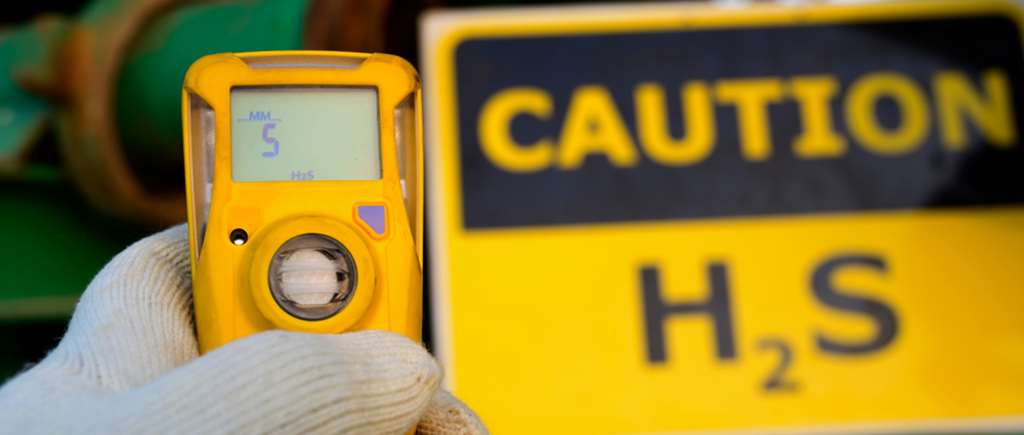Hydrogen sulfide (H2S) is a toxic gas characterised by a rotten egg odour at low concentrations while being odourless at high concentrations (>100 ppm). H2S can be present in sub-surface formation as a gas or in dissolved form in water/brine. If the oil or gas contains significant amounts of H2S, it is referred to as ‘sour’. The presence of H2S in the oil field makes the extraction and processing of hydrocarbons difficult. Exposure to H2S at high concentrations can be fatal, and the gas also has the ability to corrode pipelines and equipment.

Hydrogen Sulfide
H2S formation
H2S is naturally produced in the reservoir from dissolved sulfates by sulfate-reducing bacteria (SRB) or thermochemical sulfate reduction (TSR). These two reductions reactions occur in mutually exclusive temperature regimes in the reservoir. Sulfate reduction by SRB occurs at low temperatures (< 60-80°C), while the TSR occurs at higher temperatures (80-200°C). The temperature limits for TSR are not well defined. However, the reaction is more common in the 100 - 140°C range. While the amounts of H2S produced by BSR depend on the availability of organic matter and sulfate, the accumulated H2S can be toxic to the bacteria when present at higher concentrations. Thus, an H2S concentration of more than 5-10% indicates the gas formation by TSR.
H2S Corrosion
When H2S dissolves in water, it forms a weak acid, thereby becoming a source of hydrogen ions and sulfide ions.
H2S → H+ + HS-
HS- → H+ + S2-
The sulfide ions are reactive towards carbon steel and form an insoluble corrosion product FeS.
Fe2++ S2- → FeS
In addition to the formation of FeS, the accumulation of hydrogen ions in localized areas on the pipe can lead to a reduction in the fracture resistance of the carbon steel or alloys (a process known as hydrogen embrittlement or hydrogen stress cracking), thereby making the steel brittle and prone to failure. This is also referred to as sulfide stress cracking (SSC). Thus, in addition to the toxicity risks of H2S, it is essential to minimize the presence of H2S to prolong the life of equipment and facilities.
The dissociation of H2S is dependent on its pH. As the pH increases, H2S dissociates into bisulfide (HS-) ions from pH = 5. At pH 9 - 9.5, almost 100% of H2S is present in HS- form. As pH is increased further, sulfide (S2-) ions are formed. It is, therefore, a practice to maintain a pH >10 to avoid encountering gaseous H2S.
H2S Control - Scavengers
H2S can be removed from the system by using chemicals known as scavengers. The scavengers currently used in industry fall under two major categories: regenerative and non-generative scavengers. Amine based scavengers, like N-methyldiethanolamine (MDEA), are commonly used in large production facilities. MDEA selectively absorbs H2S from the gas stream, and the amine is regenerated by heating. The separated H2S is converted to sulfur via Claus Process.
Among regenerative scavengers, triazine based compounds are dominant, especially when the application temperature is less than 93°C. Triazines consist of a heterocyclic ring with molecular formula C3H3N3. Typically, one mole of triazine reacts with two moles to H2S gas to produce dithiazine as the main reaction product. While reacted triazines by-products are relatively non-toxic, unreacted triazines have high aquatic toxicity and tend to cause carbonate scaling due to their basic nature. An aldehyde like glyoxal (C2H2O2) can instead be used to avoid carbonate scaling risk, but it has slower reaction kinetics than triazines. The use of organic compounds like amines, triazines, aldehydes is less environmentally friendly. Other types of scavengers are solid based, typically compounds of zinc and iron, like zinc carbonate, zinc chelate, zinc chromate and ironite sponge (Fe3O4). However, they are less efficient and can cause rheology challenges when added in drilling muds.
Metal chelating agents like ferrous gluconate and lignosulfonates complexed with zinc and iron are examples of H2S scavengers which have recently gained more prominence due to their non-toxic nature and improved ability to scavenge H2S at pH > 9. The current industry focus is, therefore, the development of greener and environmentally friendly scavengers.
